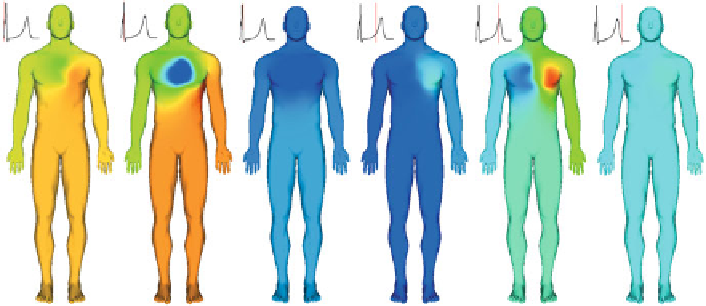Biomedical Engineering Reference
In-Depth Information
Ω
H
(
σ
i
+
σ
e
)
∇
u
n
+
e
·
∇ψ
+
Ω
H
σ
i
∇
V
n
+
m
·
∇ψ
+
Ω
T
σ
T
∇
u
n
+
T
·
∇ζ
=
0
,
(4.16)
X
H
,
h
×
X
H
,
h
∩
L
0
(
Ω
H
)
×
for all
(
φ
,
ψ
,
ζ
)
∈
X
T
,
h
with
ψ
=
ζ
on
Σ
.
At each time step, the linear problem (4.16) requires the coupled computation
of the heart potentials
and the torso potential
u
n
+
T
. This coupling can
be solved monolithically, that is, after full assembling of the whole system matrix
(see, e.g., [38, Sects. 4.6 and 4.5.1] and [11, 61, 62]). Alas, this results in an in-
creased number of unknowns with respect to the original bidomain system. More-
over, this procedure is less modular since the bidomain and torso equations cannot be
solved independently. This shortcoming can be overcome by using a partitioned it-
erative procedure based on domain decomposition (see, e.g., [55, 65]). In this study,
the heart-torso coupling is solved, in a partitioned fashion, via relaxed Dirichlet-
Neumann preconditioned Richardson iterations. A related approach is adopted in
[11] (see also [38, 53]), using an integral formulation of the torso equation.
As far as the discretization in time is concerned, alternative time-marching
schemes will be discussed in Sect. 4.5.
V
n
+
1
m
u
n
+
1
e
(
,
)
4.4.2 Simulated ECG signals
Simulations have been carried out under the modelling hypotheses described at the
beginning of this section and by solving Eqs. (4.15)-(4.16), as described in the pre-
vious paragraph. Fig. 4.4 shows some snapshots of the simulated body surface po-
tentials. The corresponding 12-lead ECG signals are given in Fig. 4.5. Despite some
minor flaws, the comparison with Fig. 4.1 (right) shows that the numerical ECGs ob-
tained have the correct amplitudes, shapes and polarities, in all the twelve standard
leads. To the best of our knowledge, this constitutes a breakthrough in the numerical
simulations of ECGs with partial differential equations.
Fig. 4.4.
Snapshots of the body surface potentials at times
t
=
10, 32, 40 ms (depolarization) and
t
=
200, 250 and 310 ms (repolarization), from left to right

